A reader recently asked if we could run a test of compact 357 Magnum revolvers to see if there was any significant difference in performance and handling with different barrel lengths. We procured three suitable compact revolvers for testing which included a new Colt King Cobra with a 3-inch barrel, a used Rossi Model 971 VRC with a 2.6-inch barrel, and a new Rock Island Armory (RIA) Model AL3.0 with a 2-inch barrel. These compact revolvers also run the budget spectrum starting with the Rossi at about $295, the RIA at $504, and the Colt at $838. Common factors between these three revolvers are double-action/single-action triggers, six-shot capacity, and steel frames. The net-net is there is a slight edge with a longer barrel in regard to velocity and energy. We can also say there are some pros and cons for both snubbies and slightly longer barrel variants. With the ammo we tested, our data shows the 3-inch barrel of the Colt had a range of 11 to 17 percent increase in velocity and energy. We’re sure we will get similar results with other ammunition brands, too.
In our opinion, these three revolvers are very traditional, meaning there really is nothing innovative about the design. If anything, the use of MIM parts in the Colt and RIA, such as the trigger and hammer, keep manufacturing costs down. The Rossi does not have any MIM parts.
With features like a short sight radius, compact grips, and triggers in DA mode that required a heavy pull, these revolvers are made for up-close work. We carried the Colt, Rossi, and RIA revolvers in a nylon Uncle Mike’s Inside the Pant holster. Before going hot at the range, we dry-fired these revolvers in DA trigger mode, doing our best Jerry Miculek impression, and some of us found we were short-stroking the trigger on the Colt and RIA. This meant they were not allowing the trigger to go fully forward and reset prior to pressing the trigger again for the next shot. This meant the trigger jammed and we needed to release the trigger to reset, then press it for the next shot. This is not a fault of the design, rather the user’s familiarity with the revolvers. No team members experienced short stroking with the Rossi. This was a reminder to our team that proper training and familiarity with your revolver is very important, if you plan to use it for self defense.
How We Tested
On the range we tested for accuracy using a rest in single-action trigger mode with targets set at 15 yards. The 357 Magnum revolver is very practical and versatile because it can fire both 38 Special and 357 Magnum cartridges. Starting at the mild end, we ran 38 Special Hornady Critical Defense loaded with a 110-grain FTX bullet. For 38 Special +P ammo, we used SIG Sauer V-Crown loaded with a 125-grain JHPs. For 357 Magnum ammo, we used Armscor brand cartridges loaded with a 158-grain FMJ bullets. We felt this was a good range of bullet weights and velocities. For speed shooting, we kept the target at 15 yards and fired in DA mode as fast as we could while still being accurate. We pushed ourselves to that edge where too much speed with the trigger can have a negative impact on accuracy. We did not experience any short stroking during this phase of testing. We did see groups enlarge dramatically, but we were capable of keeping shots in an 8- to 10-inch circle. We also used Tuff Products 6-round QuickStrip speed loaders ($9.45 for two strips at TuffProducts.com). These are made of a black flexible urethane material that allows you load two rounds at a time. Here’s what else we found when we took the guns to the range.
Range Data
| Armscor 357 Magnum 158-gr. FMJ | Colt King Cobra | Rossi 972 VRC | RIA AL3.0 |
| Average Velocity | 1075 fps | 966 fps | 961 fps |
| Muzzle Energy | 405 ft.-lbs. | 327 ft.-lbs. | 324 ft.-lbs. |
| Smallest Group | 1.5 in. | 1.3 in. | 0.9 in. |
| Average Group | 1.8 in. | 1.4 in. | 1.0 in. |
| SIG Sauer 38 Special +P 125-gr. JHP | Colt King Cobra | Rossi 972 VRC | RIA AL3.0 |
| Average Velocity | 990 fps | 846 fps | 827 fps |
| Muzzle Energy | 272 ft.-lbs. | 199 ft.-lbs. | 190 ft.-lbs. |
| Smallest Group | 1.2 in. | 2.0 in. | 1.5 in. |
| Average Group | 1.6 in. | 2.5 in. | 1.8 in. |
| Hornady Critical Defense 38 Sp. 110-gr. FTX | Colt King Cobra | Rossi 972 VRC | RIA AL3.0 |
| Average Velocity | 950 fps | 851 fps | 839 fps |
| Muzzle Energy | 220 ft.-lbs. | 177 ft.-lbs. | 172 ft.-lbs. |
| Smallest Group | 1.8 in. | 1.7 in. | 1.3 in. |
| Average Group | 1.9 in. | 2.2 in. | 1.5 in. |
Rossi Model 971 VRC 357 Magnum, $295
GUN TESTS GRADE: B
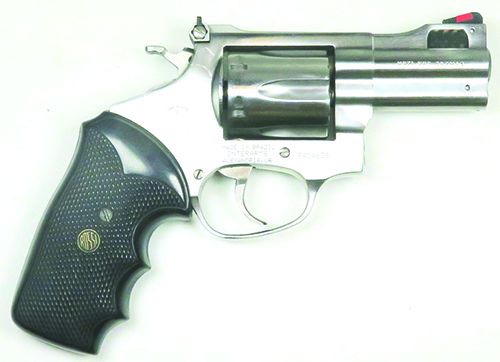
| Action Type | Revolver, DA/SA |
| Overall Length | 8.00 in. |
| Barrel Length | 2.60 in. |
| Sight Radius | 3.85 in. |
| Overall Height | 5.25 in. |
| Maximum Width | 1.45 in. |
| Weight Unloaded | 33.8 oz. |
| Weight Loaded | 34.70 oz. |
| Cylinder Gap | 0.003 in. |
| Capacity | 6 |
| Frame Finish | Bright stainless |
| Barrel/Cylinder Finish | Bright stainless |
| Frame Front Strap Height | 2.30 in. |
| Frame Back Strap Height | 3.30 in. |
| Grip | Rubber, checkered, finger grooves |
| Grip Thickness (max) | 1.15 in. |
| Grip Circumference (max) | 5.12 in. |
| Front Sight | Serrated ramp, red insert, removable |
| Rear Sight | Adj. white outline, serrated |
| Trigger Pull Weight (DA) | 11.03 lbs. |
| Trigger Pull Weight (SA) | 3.80 lbs. |
| Trigger Span (DA) | 3.10 in. |
| Trigger Span (SA) | 2.62 in. |
| Safety | Internal hammer block, security lock |
| Warranty | Limited warranty |
| Telephone | (305) 474-0401 |
| Website | RossiUSA.com |
| Made In | Brazil |
The Model 971 VRC (Vent Rib Compensated) is a used revolver that is fairly common to find on GunBroker.com and GunsAmerica.com auction websites. This model was manufactured from 1996 through 1998 and imported by Interarms. The 971’s size and function is similar to a Smith & Wesson K-frame but with a J-frame sized grip. Our sample was made from stainless steel and wore a bright finish. The grip is checkered rubber with finger grooves and slight palm swell similar to a Pachmayr Gripper grip. We liked the heft and feel of the Rossi. It was also the heaviest revolver, weighing 33.8 ounces unloaded.
The barrel has a similar design as the Tracker series of revolvers by Taurus, with a ported chamber about 0.8 inches deep at the muzzle. This chamber is counterbored, so it is not rifled. There are eight ports that spew gases and help keep the revolver from flipping when fired. Four ports are located at the 1 and 11 o’clock positions. We thought the ports did a good job of helping us get back on target when shooting for speed. The barrel also has a full lug, which helps give the Rossi some heft. This weight makes firing with hot 357 Magnum loads more tolerable.
The front sight is a pinned, serrated ramp with a red insert similar to what S&W equipped its revolvers with a decade or so ago. The rear sight is a white-outlined notch that is adjustable for windage and elevation, and the rear face of the sight is serrated to reduce glare. Whoever owned this revolver before us must have had eye-dominance issues because this revolver grouped beautifully, but 4 inches to the left of point of aim. We easily adjusted the sights even though there were no indication for up/down and left/right. Between the sights is a wide rib that is serrated. On longer-barreled 971 variants, this is a ventilated rib. We noticed the there was a sharp corner on the frame where the barrel screws into the frame. This is due to a chamfer milled into the rib but not on the topstrap. We also found some sharp edges on the muzzle edge of the under lug that made reholstering a bit more difficult. We checked gap and bore to chamber alignment prior to shooting and found it in spec.
The cylinder latch is full size and is pressed forward to swing out the cylinder. The cylinder locks in place at the rear and in the front via a pin that protrudes into the ejector rod. The end of the ejector rod was knurled. Frame-to-crane fit was good, as was the side plate fitted on the right side of the revolver. There was only a slight wiggle in the cylinder. Lock up was tight. The trigger was wide and smooth. The hammer spur was large, with plenty of toothy checkering for a sure grip. The firing pin is housed in the hammer like old-school revolvers, and the Rossi uses a hammer-stop internal safety. The trigger needs to be fully to the rear to allow the hammer and firing pin to fire a round.
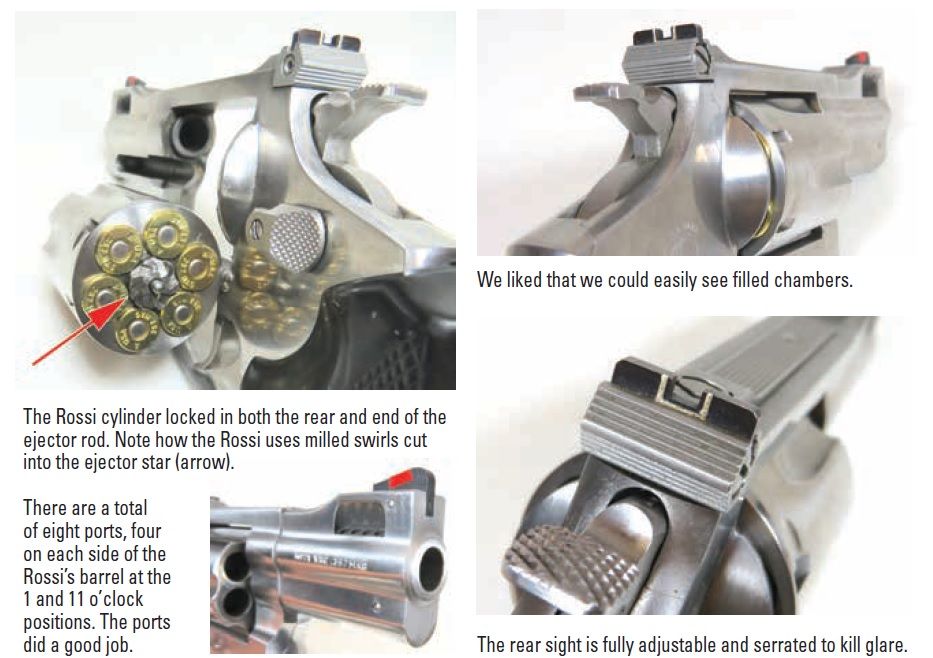
Going hot, we found the trigger in DA mode required 11 pounds of finger pressure to work back and then fall. The pull weight, however, seemed less, due to the fact the trigger pull was smooth with nearly no stacking. In accuracy testing, the best five-shot group measured 1.3 inches with the Armscor 357 Magnum loaded with a 158-grain FMJ bullet. The average accuracy was 2 to 2.5 inches and is fine for self-defense situations. In the speed-shooting phase of the test, the Rossi showed less muzzle rise than the other revolvers. The weight of the Rossi helps with felt recoil. With 38 Special ammo, the Rossi is a pussycat to shoot; with hotter 357 Magnums, it is very tolerable, making the Rossi the most comfortable revolver to shoot with hot loads. We did note in the data that the velocity and energy were less than the Colt with the longer barrel. The Rossi’s numbers were a bit higher than the RIA’s numbers. Empties were easily ejected and with no issues.
The 971 VRC was carried in a nylon Uncle Mike’s Inside the Pant holster. This revolver does make its presence known compared to light-weight aluminum-framed 357 revolvers. That’s part of the trade off with these heavier revolvers: more comfortable to shoot, less comfortable to carry.
Our Team Said: The 971 VRC is a low-cost alternative to a more expensive and new 357 Magnum. Though accuracy was not stellar, it was good enough for self defense. We liked the ported barrel’s ability to help keep us on target and the great trigger. If you find one in good condition, this could make a good self-defense revolver.
Colt King Cobra KCOBRA-SB3BB 357 Magnum, $838
GUN TESTS GRADE: A
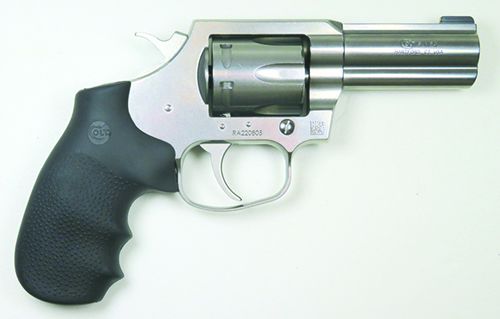
| Action Type | Revolver, DA/SA |
| Overall Length | 8.0 in. |
| Barrel Length | 3.0 in. |
| Sight Radius | 4.35 in. |
| Overall Height | 5.0 in. |
| Maximum Width | 1.4 in. |
| Weight Unloaded | 28 oz. |
| Weight Loaded | 28.9 oz. |
| Cylinder Gap | 0.003 in. |
| Capacity | 6 |
| Frame Finish | Matte stainless |
| Barrel/Cylinder Finish | Matte stainless |
| Frame Front Strap Height | 2.0 in. |
| Frame Back Strap Height | 3.1 in. |
| Grip | Hogue Overmolded, textured finger grooves, rubber |
| Grip Thickness (max) | 1.2 in. |
| Grip Circumference (max) | 5.1 in. |
| Front Sight | Brass bead post, removable |
| Rear Sight | Fixed notch |
| Trigger Pull Weight (DA) | 8.6 lbs. |
| Trigger Pull Weight (SA) | 3.5 lbs. |
| Trigger Span (DA) | 3.2 in. |
| Trigger Span (SA) | 2.7 in. |
| Safety | Transfer bar |
| Warranty | None written |
| Telephone | (800) 962-2658 |
| Website | Colt.com |
| Made In | USA |
The new King Cobra is different from the original King Cobra models made from 1986 through 1992. Unlike the original King Cobras, which were closer in size and proportion to a Smith & Wesson L-frame, the new model is lighter and more concealable. It also has fixed sights; original King Cobra revolvers had an adjustable rear sight. Our sample wore a semi-bright stainless finish, which we thought was well executed. The trigger guard is flat on the bottom edge and gives the revolver a distinct look.
The King Cobra shares many parts with the new Cobra, including its internal lockwork, grip and sights. It uses a leaf mainspring design, which is better than the coil-spring arrangement found on vintage King Cobras. The DA trigger exhibited no stacking effect and was very smooth and consistent. Pull weight was just over 8 pounds, which we liked. The trigger was narrow and smooth. We would have preferred the trigger to be a bit wider. The hammer spur was narrow and as wide as the hammer. The serrations on the spur worked well. The King’s hammer was easy to cock, with no slippage. The firing pin is captive in the frame. The internal safety is a transfer-bar system, so the trigger needs to be fully rearward to allow the hammer to hit the transfer bar, which then hits the firing pin.
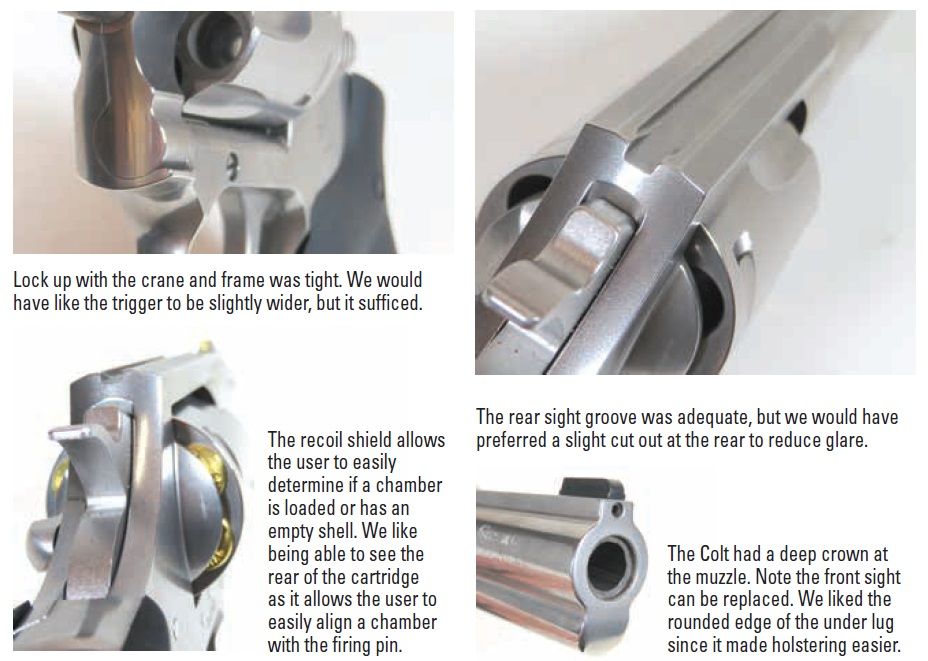
The barrel is one-piece, machined from stainless steel, with a deeply recessed crown at the muzzle. The top side of the barrel is milled flat. It features a full lug that adds weight, which is a check in the pro column when it comes to recoil, but also a check in con column because it adds weight. The front of the barrel and lug were rounded to aid reholstering, and the barrel was nicely mated to the frame with all smooth edges. The front-sight post is pinned in place and wears a brass bead. The rear sight is a groove milled in the topstrap. The top side is also bead blasted for a matte finish. We felt these sights were well suited for the intended purpose of self defense. The sights were large as well as smooth and snag free, which is also appropriate in a concealed-carry weapon.
The grip is a one-piece Hogue Overmolded model with finger grooves, a pebbled texture and round butt. In our opinion, this grip was good for concealed carry and helped with recoil. All of our fingers had space on the grip and didn’t leave our pinky finger dangling.
The cylinder latch is pulled back to swing out the cylinder, the opposite of an S&W-style revolver. Also note that the cylinder rotates clockwise, or into the frame. A S&W and the Rossi and RIA rotate counter clockwise. This is important to remember when trying to line up a specific chamber with the firing pin. The Colt’s cylinder locked only in the rear. The ejector rod was knurled. The crane was tightly mated to the frame, and there was only slight wiggle in the cylinder. We did note the recoil plate allowed the user to see if a chamber was loaded or had an empty case. We like this feature, especially when you want to align a certain chamber.
In our opinion, the Hogue grip with finger grooves and crisp SA trigger allowed us to shoot the King Cobra accurately. Our best five-shot group measured 1.2 inches and was fired with SIG 38 Special +P ammo loaded with a 125-grain JHP. The grip also helped to dissipate recoil in the palm of the hand. With 38 Special and 357 Magnum ammunition, our average groups measured 1.9 and 1.8 inches, respectively. As mentioned, we saw an 11- to 17-percent increase in velocity and energy with the King’s longer 3-inch barrel. We also found carrying the King took more effort, and it wasn’t as easily concealable due to length. In DA mode and using a two-hand grip, we found the revolver was easy to control, even with a bit of flip and recoil with magnum loads. We had no issues shucking empty brass.
Our Team Said: The King Cobra performed well and would be our choice of these revolvers tested if price were not an issue. We liked the sights and trigger, which helped us shoot the King Cobra well. The King Cobra offers better ballistic performance due to the longer barrel, but that is at the cost of a larger package that is less easy to carry concealed.
Rock Island Armory AL3.0 357 Magnum, $504
GUN TESTS GRADE: A-
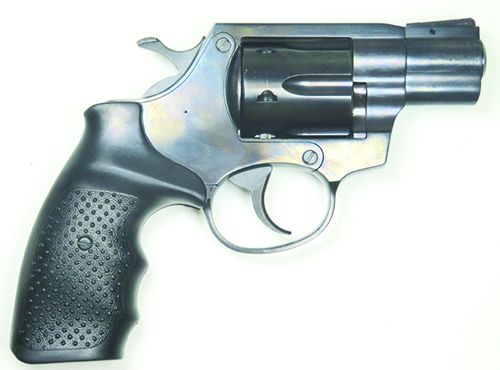
| Action Type | Revolver, DA/SA |
| Overall Length | 6.75 in. |
| Barrel Length | 2.0 in. |
| Sight Radius | 3.90 in. |
| Overall Height | 4.09 in. |
| Maximum Width | 1.50 in. |
| Weight Unloaded | 32.1 oz. |
| Weight Loaded | 35.6 oz. |
| Cylinder Gap | 0.004 in. |
| Capacity | 6 |
| Frame Finish | Blued |
| Barrel/Cylinder Finish | Blued |
| Frame Front Strap Height | 2.3 in. |
| Frame Back Strap Height | 3.3 in. |
| Grip | Rubber, textured finger grooves rubber |
| Grip Thickness (max) | 1.25 in. |
| Grip Circumference (max) | 5.12 in. |
| Front Sight | Serrated ramp, removable |
| Rear Sight | Fixed notch |
| Trigger Pull Weight (DA) | 11.56 lbs. |
| Trigger Pull Weight (SA) | 4.03 lbs. |
| Trigger Span (DA) | 3.30 in. |
| Trigger Span (SA) | 2.92 in. |
| Safety | Transfer bar |
| Warranty | Limited lifetime |
| Telephone | (775) 537-1444 |
| Website | Armscor.com |
| Made In | Czech Republic (imported by RIA) |
RIA imports the AL3.0 from Alpha Proj in the Czech Republic. We tested a target variant of one these revolvers years ago and it failed miserably. Our expectations were not high, but we test with an open mind. The finish on the RIA was suspect. The frame wore a blue/black color, but when the light hit it just right, it looked like a plum color. The crane specifically had a plum color. Not the best finish, in our opinion.
The rubber grip is full size with finger grooves and a pebble finish and a palm swell. We liked these grips because it made the RIA more comfortable to shoot. It also made the revolver more difficult to conceal.
The 2-inch two-piece barrel features a full lug and enclosed the ejector rod. The edges on the lug are sharp, and we’d prefer more rounded edges for ease when holstering. The edge in the cut out for the ejector rod was sharp, too. The barrel assembly uses a barrel and steel barrel sleeve, similar to how S&W builds some of its revolvers. There is a slight crown on the muzzle. The front ramp sight is serrated and pinned in place. The rear sight is a groove milled in the top strap. The serrations on the ramp front sight really cut sun glare.
The cylinder latch is similar to an S&W. Push is forward to swing out the cylinder. The latch itself was serrated yet smoothn with a lip that provided leverage when pushing it forward. There are, however, big differences between the RIA and the Rossi and other S&W-like revolvers. What is different about the RIA is the way the crane mates with the frame. The RIA’s crane mates to the front side of the cylinder window, similar to a Ruger LCR or LCRx. It does not mate to the side of the frame like the Rossi, Colt, or an S&W. The cylinder only locks in the rear via a pin. The ejector rod is smooth. Also different is the ejector. It uses six nubs or peg-like protrusions for cylinder rotation. As the hand comes up during SA cocking or DA trigger pull, the hand connects under the nub to rotate the cylinder. Typical revolvers use a flat spiral type of protrusion. No doubt these design features cost less to manufacture the revolver. The cylinder rotates counter clockwise. The chambers are countersunk. The recoil plate is nearly to the outer edge of the cylinder, so it is difficult see if a chamber has a case in it or if it is loaded.
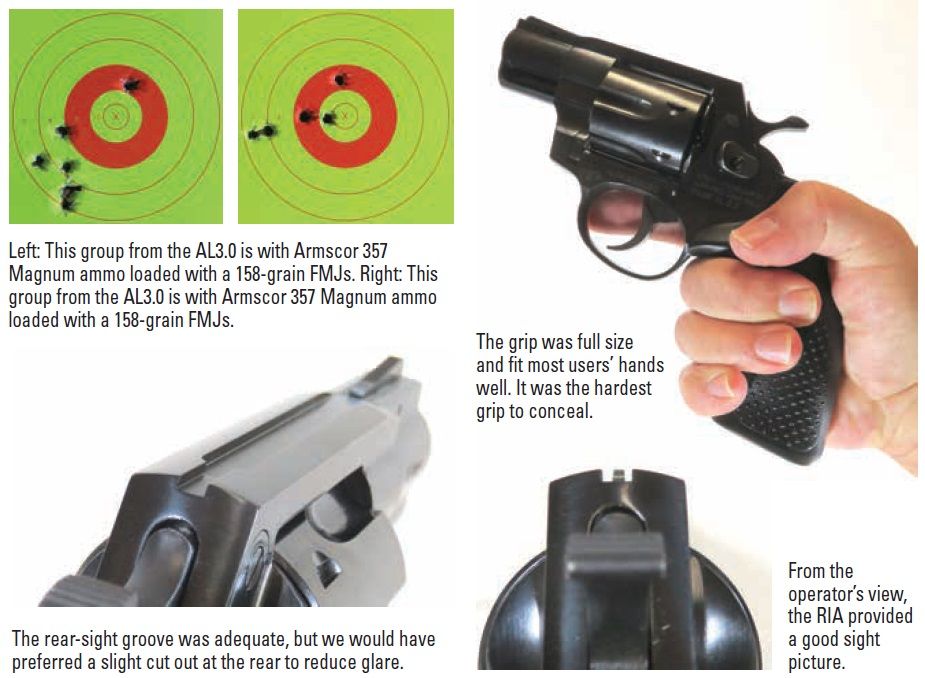
The trigger was wide and finely serrated. The hammer spur was wide and offered grippy serrations for cocking back the hammer. The internal safety system is a transfer bar, which means the trigger must be fully rearward for the hammer to hit the transfer bar and then the firing pin. The firing pin is mounted in the frame.
Going hot, we were surprised at the accuracy of the AL3.0. It shot circles around the Rossi and Colt. Our best five-shot group measured 0.9 inches with the hot Armscor 357 Mag ammo loaded with a 158-grain FMJs. With the 38 Special Hornady load and the 38 Special +P SIG load, the average five-shot groups measured 1.5 and 1.8 inches, respectively. In hand, the AL3.0 is hefty. At 35.6 ounces loaded, this revolver’s weight helps reduce felt recoil. Between the full grip and heavy weight, it made the AL3.0 comfortable to shoot even with hot magnum loads. For speed shooting, the RIA allowed us to stay on target and manage recoil.
We did encounter a slight bit of stacking with the RIA, and, overall, the trigger pull was fairly smooth and consistent. Stacking occurs when firing a revolver in DA mode. The user can feel extra resistance as the trigger is pulled through a full DA stroke. This is caused by the coiled mainspring compressing. The DA pull took over 11 pounds, and it felt like it. We would have preferred a lighter DA pull. SA pull required only 4 pounds, and that was more acceptable for accurate shooting.
The ejector-rod stroke on the AL3.0 is not long enough to fully eject empties, so remember to use a gravity assist. We had no issues discharging brass.
Our Team Said: The AL3.0 had really good accuracy. We appreciated the weight and full grip when shooting invigorating magnum loads. The weight and full grip make it harder to conceal carry, but in our opinion, this could make a good mid-priced wheelgun for home defense. We dinged it half a grade due to the inconsistent finish.
Special thanks to Eastern Outfitters (EasternOutfitter.com) of Hampstead, NC, for their assistance.
Written and photographed by Robert Sadowski, using evaluations from Gun Tests team testers.



























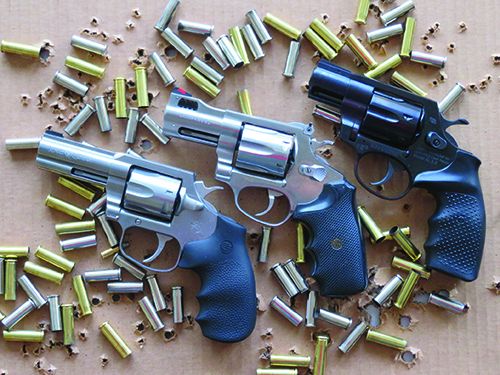

Great article! I have noticed thst revolvers have really had a resurgence as of late. I think it is because people long for the craftsmanship you get in a revolver. In our modern world you don’t see good craftsmanship anymore. Everything is plastic mass produced and seem soulless . I am itching for a revolver but can not seem to make my mind up. I was hoping to get a Rossi . 357 used because they offer a heck of alot of quality for a good price however as if late they are selling at a premium on Gunbroker so I figure why not spend a couple hundred more bucks for a S&W. The Ruger’s are built like a tank but I prefer the classic lines of the S&W, Colt and Rossi. Hopefully I can fibd a good deal on one.